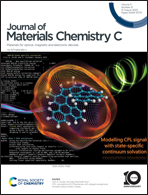Enhancing the efficiency of Cu2ZnSn(S,Se)4 solar cells by variable-temperature sulfoselenization†
Abstract
High-temperature sulfoselenization is essential in producing Cu2ZnSn (S,Se)4 (CZTSSe) thin-film solar cells. At high temperature, the Cu2ZnSn(S,Se)4 phase-transition speed is fast, which causes grain transition to mature quickly, followed by grain decomposition. Although grain surfaces are relatively flat at low temperatures, the small grain and more grain boundaries lead to low efficiency. In this study, a dynamic-temperature sulfoselenization process was adopted to utilize both the advantages of high and low temperatures comprehensively. Different constant- and variable-temperature sulfoselenization processes were developed for annealing Cu–Zn–Sn–S precursor films prepared in the air using dimethyl sulfoxide (DMSO) and 2-methoxyethanol (MOE) dual solvent systems. As a result, CZTSSe films with a flat, holeless, and dense surface, and a single-layer large grain penetrating the whole cross-section were fabricated by a proper variable-temperature sulfoselenization process. Finally, 11.11% total-area power conversion efficiency (12.22% active area efficiency) of CZTSSe solar cells (without antireflection coating) based on the variable-temperature sulfoselenization process was achieved successfully. Compared with the highest efficiency of 9.10% of CZTSSe film solar cells fabricated from the stable-temperature sulfoselenization annealing process, the efficiency was improved by 22%. The variable-temperature annealing processes in this study can also be applied to the preparation of other multi-element thin-film semiconductor materials.



 Please wait while we load your content...
Please wait while we load your content...